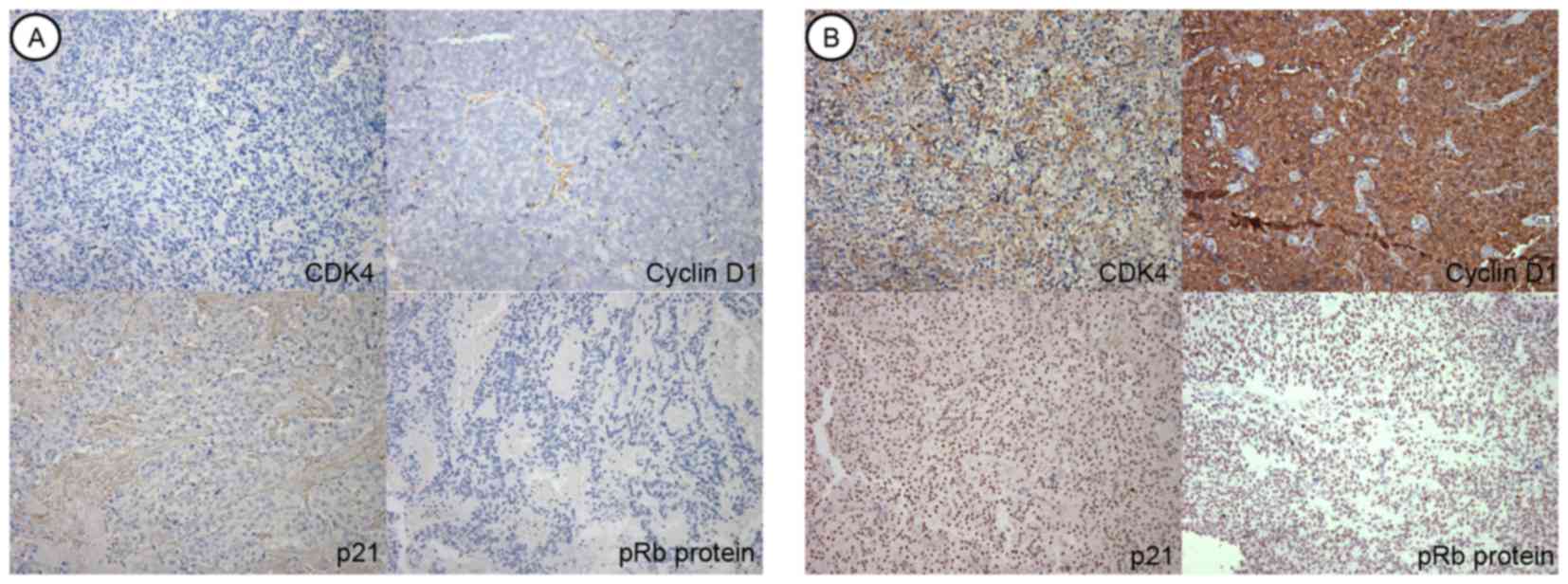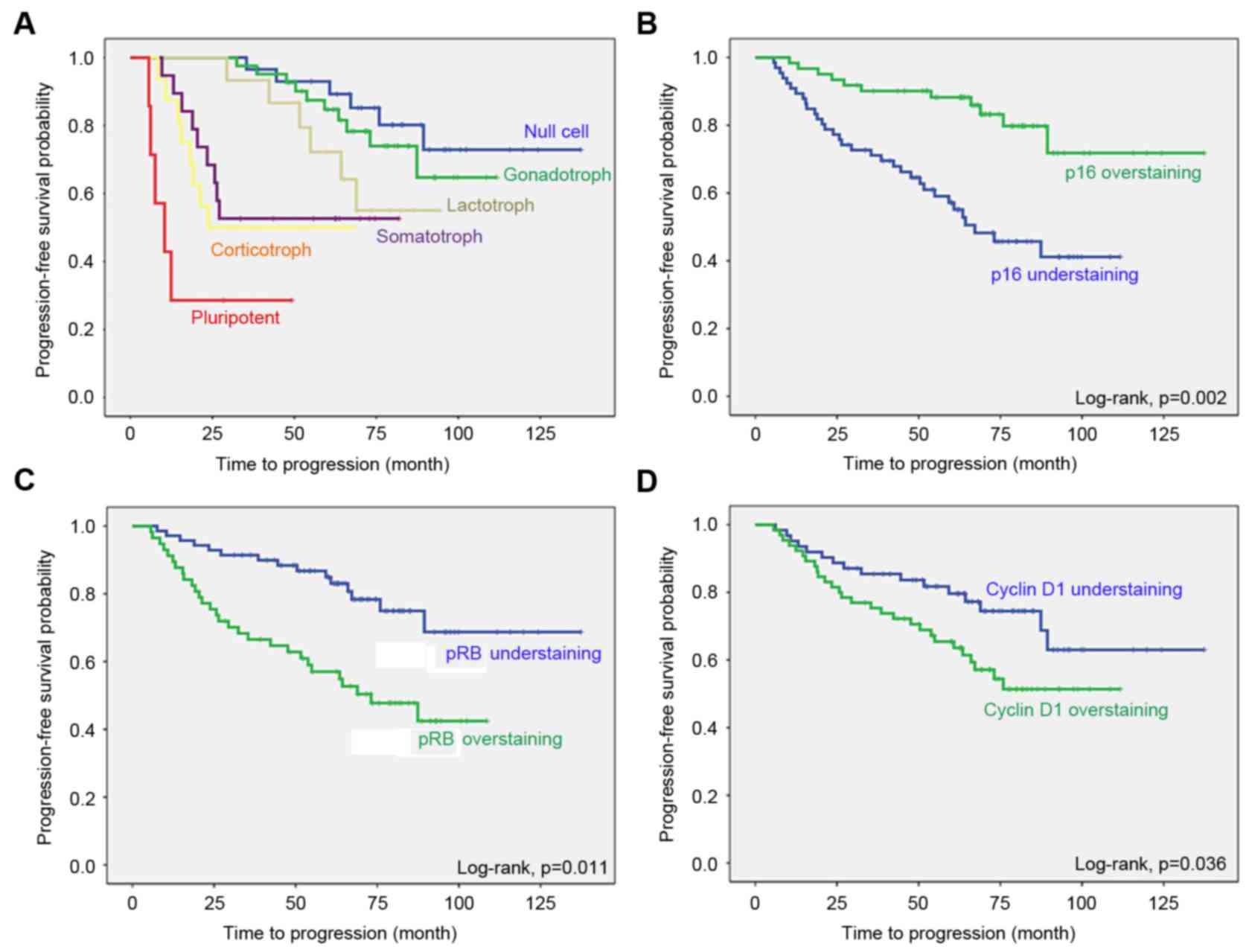|
1
|
Kovacs K, Horvath E and Vidal S:
Classification of pituitary adenomas. J Neurooncol. 54:121–127.
2001. View Article : Google Scholar : PubMed/NCBI
|
|
2
|
Mayson SE and Snyder PJ: Silent pituitary
adenomas. Endocrinol Metab Clin North Am. 44:79–87. 2015.
View Article : Google Scholar : PubMed/NCBI
|
|
3
|
Fernandez A, Karavitaki N and Wass JA:
Prevalence of pituitary adenomas: A community-based,
cross-sectional study in Banbury (Oxfordshire, UK). Clin Endocrinol
(Oxf). 72:377–382. 2010. View Article : Google Scholar : PubMed/NCBI
|
|
4
|
Raappana A, Koivukangas J, Ebeling T and
Pirilä T: Incidence of pituitary adenomas in Northern Finland in
1992–2007. J Clin Endocrinol Metab. 95:4268–4275. 2010. View Article : Google Scholar : PubMed/NCBI
|
|
5
|
Mayson SE and Snyder PJ: Silent
(clinically nonfunctioning) pituitary adenomas. J Neurooncol.
117:429–436. 2014. View Article : Google Scholar : PubMed/NCBI
|
|
6
|
Syro LV, Rotondo F, Ramirez A, Di Ieva A,
Sav MA, Restrepo LM, Serna CA and Kovacs K: Progress in the
diagnosis and classification of pituitary adenomas. Front
Endocrinol (Lausanne). 6:972015.PubMed/NCBI
|
|
7
|
Horvath E, Kovacs K, Killinger DW, Smyth
HS, Platts ME and Singer W: Silent corticotropic adenomas of the
human pituitary gland: A histologic, immunocytologic, and
ultrastructural study. Am J Pathol. 98:617–638. 1980.PubMed/NCBI
|
|
8
|
Horvath E, Kovacs K, Smyth HS, Killinger
DW, Scheithauer BW, Randall R, Laws ER Jr and Singer W: A novel
type of pituitary adenoma: Morphological features and clinical
correlations. J Clin Endocrinol Metab. 66:1111–1118. 1988.
View Article : Google Scholar : PubMed/NCBI
|
|
9
|
Klibanski A: Nonsecreting pituitary
tumors. Endocrinol Metab Clinic North Am. 16:793–804. 1987.
|
|
10
|
Randall RV, Scheithauer W and Laws ER Jr:
Hormone-containing, non-secreting pituitary tumors: Clinically
silent monohormonal pituitary adenomas. Trans Am Clin Climatol
Assoc. 96:98–103. 1985.PubMed/NCBI
|
|
11
|
Scheithauer BW, Kovacs KT, Laws ER Jr and
Randall RV: Pathology of invasive pituitary tumors with special
reference to functional classification. J Neurosurg. 65:733–744.
1986. View Article : Google Scholar : PubMed/NCBI
|
|
12
|
Landolt AM, Shibata T and Kleihues P:
Growth rate of human pituitary adenomas. J Neurosurg. 67:803–806.
1987. View Article : Google Scholar : PubMed/NCBI
|
|
13
|
Knosp E, Kits K and Perneczky A:
Proliferation activity in pituitary adenomas: Measurement by
monoclonal antibody Ki-67. Neurosurgery. 25:927–930. 1989.
View Article : Google Scholar : PubMed/NCBI
|
|
14
|
Losa M, Franzin A, Mangili F, Terreni MR,
Barzaghi R, Veglia F, Mortini P and Giovanelli M: Proliferation
index of nonfunctioning pituitary adenomas: Correlations with
clinical characteristics and long-term follow-up results.
Neurosurgery. 47:1313–1319. 2000. View Article : Google Scholar : PubMed/NCBI
|
|
15
|
Yonezawa K, Tamaki N and Kokunai T:
Clinical features and growth fractions of pituitary adenomas. Surg
Neurol. 48:494–500. 1997. View Article : Google Scholar : PubMed/NCBI
|
|
16
|
Malumbres M and Barbacid M: To cycle or
not to cycle: A critical decision in cancer. Nat Rev Cancer.
1:222–231. 2001. View
Article : Google Scholar : PubMed/NCBI
|
|
17
|
Srivastava V, Patel B, Kumar M, Shukla M
and Pandey M: Cyclin D1, retinoblastoma and p16 protein expression
in carcinoma of the gallbladder. Asian Pac J Cancer Prev.
14:2711–2715. 2013. View Article : Google Scholar : PubMed/NCBI
|
|
18
|
Cho HY, Cho SW, Kim SW, Shin CS, Park KS
and Kim SY: Silent corticotroph adenomas have unique recurrence
characteristics compared with other nonfunctioning pituitary
adenomas. Clin Endocrinol (Oxf). 72:648–653. 2010. View Article : Google Scholar : PubMed/NCBI
|
|
19
|
Knosp E, Steiner E, Kitz K and Matula C:
Pituitary adenomas with invasion of the cavernous sinus space: A
magnetic resonance imaging classification compared with surgical
findings. Neurosurgery. 33:610–618. 1993. View Article : Google Scholar : PubMed/NCBI
|
|
20
|
Shim JH, Song YJ, Kim DC, Park MK, Choi SS
and Kim KU: Silent adenomas of pituitary gland: It's
immunohistochemical features and clinical characteristics. J Korean
Neurosurg Soc. 40:330–335. 2006.
|
|
21
|
Eng J: Receiver operating characteristic
analysis: A primer. Acad Radiol. 12:909–916. 2005. View Article : Google Scholar : PubMed/NCBI
|
|
22
|
Chen Y, Wang CD, Su ZP, Chen YX, Cai L,
Zhuge QC and Wu ZB: Natural history of postoperative nonfunctioning
pituitary adenomas: A systematic review and meta-analysis.
Neuroendocrinology. 96:333–342. 2012. View Article : Google Scholar : PubMed/NCBI
|
|
23
|
Kirsch M, Mörz M, Pinzer T, Schackert HK
and Schackert G: Frequent loss of the CDKN2C (p18INK4c) gene
product in pituitary adenomas. Genes Chromosomes Cancer.
48:143–154. 2009. View Article : Google Scholar : PubMed/NCBI
|
|
24
|
Gayed BA, Youssef RF, Bagrodia A, Kapur P,
Darwish OM, Krabbe LM, Sagalowsky A, Lotan Y and Margulis V:
Prognostic role of cell cycle and proliferative biomarkers in
patients with clear cell renal cell carcinoma. J Urol.
190:1662–1667. 2013. View Article : Google Scholar : PubMed/NCBI
|
|
25
|
Kishimoto I, Mitomi H, Ohkura Y, Kanazawa
H, Fukui N and Watanabe M: Abnormal expression of p16(INK4a),
cyclin D1, cyclin-dependent kinase 4 and retinoblastoma protein in
gastric carcinomas. J Surg Oncol. 98:60–66. 2008. View Article : Google Scholar : PubMed/NCBI
|
|
26
|
Guo LL, Gao P, Wu YG, Jian WC, Hao CY, Li
H and Lin XY: Alteration of cyclin D1 in Chinese patients with
breast carcinoma and its correlation with Ki-67, pRb, and p53. Arch
Med Res. 38:846–852. 2007. View Article : Google Scholar : PubMed/NCBI
|
|
27
|
Morgan D, Murray A, Hunt T and Nurse P:
The Cell Cycle and Programmed Cell DeathAlberts B, Johnson A, Lewis
J, Raff M, Roberts K and Walter P: Molecular Biology of the Cell.
Garland Science; New York: pp. 983–1026. 2002
|
|
28
|
Horvath E and Kovacs K: The
AdenohypophysisFunctional Endocrine Pathology. Kovacs K and Asa SL:
Blackwell; Boston, MA: pp. 245–281. 1990
|











